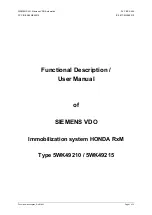
•
Do not install near vents, flues, chimneys, or any
forced/unforced air ventilation openings.
•
Do not install on metal surfaces.
•
Avoid mounting in areas with a large quantity of metal or
electrical wires.
•
Do not install near ceiling fans, doors, windows, or areas
directly exposed to the weather.
•
Do not install in dead air spaces, such as peaks of vaulted
ceilings or gabled roofs, where CO may not reach the
sensor in time to provide early warning.
•
Do not install near deep-cell large batteries. Large
batteries have emissions that can cause the alarm to
perform at less than optimum performance.
•
Do not obstruct the vents located on the alarm. Do not
place the alarm where drapes, furniture, or other objects
block the flow of air to the vents.
Battery installation and replacement
Note:
Place the control panel into sensor test mode prior to
replacing the batteries. If the control panel is not in sensor test
mode during battery replacement, an alarm/tamper condition
may be indicated.
To install or replace the batteries in this alarm:
1. Slide the alarm body off of the mounting plate.
2. If replacing batteries, remove the old batteries and
properly dispose of them as recommended by the battery
manufacturer.
3. Install the new batteries. Note the polarity illustration in the
battery compartment (see Figure 3 below).
Figure 3: Batteries
W
A
R
N
IN
G
X
X
X
X
X
X
X
X
X
X
X
X
X
X
X
X
X
X
X
X
X
X
X
X
X
X
X
X
X
X
X
X
X
X
X
X
X
X
X
X
X
X
X
X
X
X
X
X
X
X
X
X
X
X
X
X
X
X
X
X
X
X
X
X
X
X
X
X
X
X
X
X
X
X
X
X
X
X
X
X
X
X
X
X
X
X
X
X
X
X
X
X
X
X
X
X
X
X
X
X
Battery compartment
_
+
_
4. Slide the alarm body back onto the mounting plate.
Note:
The mounting plate will not close if all three
batteries are not installed.
Figure 4: Sliding the alarm on the mounting plate
Alarm mounting guide
Alarm mounting guide
5. Perform a sensor/RF test with the control panel. See “RF
communication test” on page 3
When replacing the batteries, use one of the following
approved brands:
•
Duracell MN1500 or MX1500
• Energizer
E91
Note:
For battery replacement information, see interlogix.com.
Use of a different battery may have a detrimental effect on the
alarm operation.
Note:
Constant exposures to high or low humidity may reduce
battery life.
After installing or changing the batteries, reinstall your alarm.
Test your alarm by using the Test/Hush button and check that
the green Power LED is on.
Mounting the alarm
Note:
Verify RF performance prior to permanently mounting
the alarm. See “RF communication test” on page 3.
The CO alarm can be wall mounted or ceiling mounted.
To mount the alarm:
1. Slide the alarm body off of the mounting plate. Place the
mounting plate in the desired location, and mark the
location of the two mounting holes. Orient the mounting
plate vertically or horizontally as shown in the following
figures.
Note:
The alarm can also be directly mounted to a single
gang box.
Figure 5: Vertical mounting
Mounting hole
Mounting latch
Alarm
procedure
label
Warning
XXXXxx XXX x xxx
XX XXX XXXXxxx
XXXX XXX XXXxx
XXXXXXXX XX xx
XXXXxx XXX x xx
XX XXX XXXX xx
XXXX XXX XXXxx
XXXXXXXX XX xx
XXXXxx XXX xxx
XX XXX XXXXxx
XXXX XXX XXXx
XXXXXXXX XX
XXXXxx XXX xxx
XX XXX XXXX xx
XXXX XXX X X
XXXXXXXX XXxx
xxxxxxxxxxx
XXXXxxx
xxxxxxxxxxx
Mounting hole
2 / 8
P/N 466-2393 • REV A • ISS 14FEB11


























